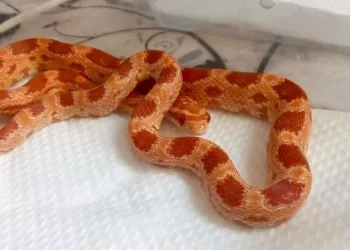Corn snakes (Pantherophis guttatus) are a species of non-venomous constrictor snakes native to North America. They are known for their striking coloration, docile nature, and popularity in the pet trade. Understanding where corn snakes live, both in their natural habitat and as pets, is crucial for providing them with the appropriate care and environment. This article will explore the corn snake’s habitat, geographical distribution, behavior in the wild, and considerations for their care in captivity.
1. Natural Habitat of Corn Snakes
Geographical Range
Corn snakes are primarily found in the southeastern United States. Their range extends from New Jersey to Florida and westward to Louisiana and parts of the Midwest. Specific states where corn snakes are commonly found include:
Florida: With its diverse ecosystems, Florida offers a variety of habitats that support corn snake populations. The warm climate and availability of prey make it an ideal environment.
Georgia: The southern region of Georgia is home to corn snakes, which thrive in the state’s forests, fields, and wetlands.
North Carolina: Corn snakes are prevalent in various habitats across North Carolina, including woodlands and agricultural areas.
Tennessee: In Tennessee, corn snakes are often found in forests and grasslands, as well as around human settlements.
Preferred Habitats
Corn snakes inhabit a variety of environments, each providing essential resources for their survival:
Forests: Corn snakes thrive in deciduous and mixed forests where they can find ample cover among leaves, logs, and shrubs. These environments provide excellent hunting grounds for small mammals, birds, and reptiles.
Grasslands: Open fields and grasslands are common habitats for corn snakes, especially in areas where rodent populations are high. The open terrain allows for easy movement and hunting.
Agricultural Areas: Corn snakes are often found in agricultural fields, particularly cornfields, where they prey on rodents that are attracted to the crops. This symbiotic relationship helps control pest populations in farming areas.
Swamps and Marshes: In the southern regions of their range, corn snakes can also be found in wetlands and swamps, where they use vegetation for cover and hunt for amphibians and small reptiles.
Microhabitats
Within their larger habitats, corn snakes often utilize specific microhabitats that meet their needs for thermoregulation, shelter, and hunting:
Rock Piles and Burrows: Corn snakes may hide in rock piles or burrow into loose soil to escape predators and regulate their body temperature. These structures offer protection from extreme weather conditions.
Leaf Litter: The leaf litter on the forest floor provides camouflage and hunting opportunities for corn snakes as they ambush small prey.
Tree Branches: While they are primarily ground-dwelling snakes, corn snakes are also adept climbers and may be found resting on tree branches or hunting birds.
2. Behavior in the Wild
Diet and Hunting Strategies
Corn snakes are opportunistic feeders, primarily preying on small mammals such as mice, rats, and voles. They also consume birds, lizards, and occasionally amphibians. Their hunting strategies include:
Ambush Hunting: Corn snakes often lie in wait for prey, camouflaged by their coloration. They strike quickly to capture their meal before constricting it.
Active Foraging: In areas with abundant prey, corn snakes may actively search for food, using their keen sense of smell to locate rodents.
Activity Patterns
Corn snakes are primarily crepuscular, meaning they are most active during dawn and dusk. This behavior helps them avoid the heat of the day and reduces their risk of predation. During the night, they may also hunt or engage in mating activities.
Reproduction and Lifespan
Corn snakes are oviparous, laying eggs that hatch after a period of incubation. Mating occurs in the spring, and females typically lay clutches of 10 to 30 eggs in late spring to early summer. The eggs are often deposited in loose soil or decaying vegetation, providing warmth and moisture.
The lifespan of corn snakes in the wild is generally around 6 to 8 years, though they can live much longer in captivity under optimal conditions, sometimes exceeding 20 years.
3. Corn Snakes in Captivity
Popularity as Pets
Corn snakes are one of the most popular pet snake species due to their manageable size, docile temperament, and striking coloration. Their ease of care makes them suitable for both novice and experienced snake owners.
Ideal Environments in Captivity
To successfully keep corn snakes as pets, it is essential to replicate their natural habitat as closely as possible. This includes:
Enclosure Size: A single adult corn snake requires a minimum enclosure size of 40 gallons, though larger is always better. A terrarium with horizontal space is preferred, as corn snakes are active and enjoy exploring.
Substrate: Suitable substrates include aspen shavings, cypress mulch, or coconut fiber, allowing for burrowing and providing a natural feel.
Temperature and Humidity: Corn snakes require a temperature gradient in their enclosure, with a basking spot of 85-90°F and a cooler side of 75-80°F. Humidity levels should be kept around 40-60%, which can be achieved through regular misting and a water dish.
Hiding Spots: Providing hiding spots is crucial for the snake’s mental well-being. Use rocks, logs, or commercial hides to create a sense of security.
Feeding Corn Snakes in Captivity
In captivity, corn snakes should be fed a diet consisting of appropriately sized rodents, such as mice or rats. Feeding guidelines include:
Feeding Frequency: Juvenile corn snakes should be fed every 5-7 days, while adults can be fed every 10-14 days.
Prey Size: The size of the prey should be roughly equal to the width of the snake’s body at its widest point. This ensures that the snake can comfortably consume its meal.
Frozen vs. Live Prey: While some snake owners prefer to feed live prey, frozen-thawed rodents are generally recommended to reduce the risk of injury to the snake.
Health Considerations
Maintaining the health of corn snakes in captivity involves regular veterinary check-ups and attention to common health issues, including:
Respiratory Infections: Symptoms include wheezing, open-mouth breathing, and lethargy. Maintaining proper humidity and temperature can help prevent these infections.
Mites and Parasites: Regularly inspect the snake and its enclosure for signs of mites or parasites. Treatments are available to address these issues.
Improper Shedding: Adequate humidity and appropriate substrate can help prevent retained shed skin, which can lead to health complications.
4. Conservation and Threats
Population Status
Corn snakes are not currently listed as endangered or threatened, but habitat loss and fragmentation due to urbanization and agriculture can impact their populations. Maintaining natural habitats is crucial for their continued survival.
Human Interaction
While corn snakes are beneficial to humans due to their rodent control capabilities, misconceptions about snakes can lead to them being killed out of fear. Education about the importance of snakes in ecosystems can help mitigate this issue.
Captive Breeding Programs
Captive breeding programs play a vital role in preserving corn snake populations, especially those with unique color morphs and patterns that are popular in the pet trade. Responsible breeding practices can help ensure genetic diversity and reduce the impact of wild collection.
Conclusion
Corn snakes are fascinating creatures that inhabit a variety of ecosystems across the southeastern United States. Their adaptability to different environments, combined with their striking appearance and docile nature, makes them popular as both wild inhabitants and pets. By understanding their natural habitat and behavior, pet owners can create a suitable environment that meets their needs, ensuring a healthy and fulfilling life for these beautiful snakes.
As the pet industry grows, it is essential to prioritize conservation efforts and responsible ownership practices. By respecting the natural habitats of corn snakes and supporting captive breeding initiatives, we can help preserve this remarkable species for future generations to appreciate and enjoy.
Related Topics:


























